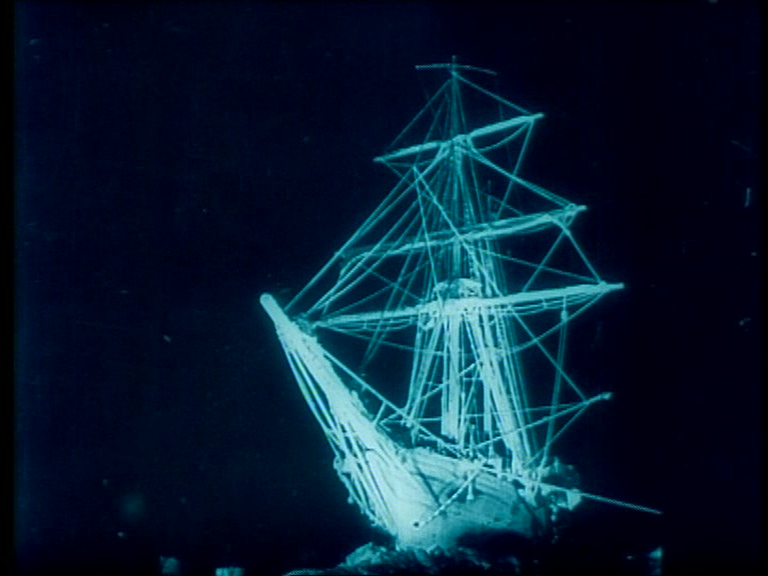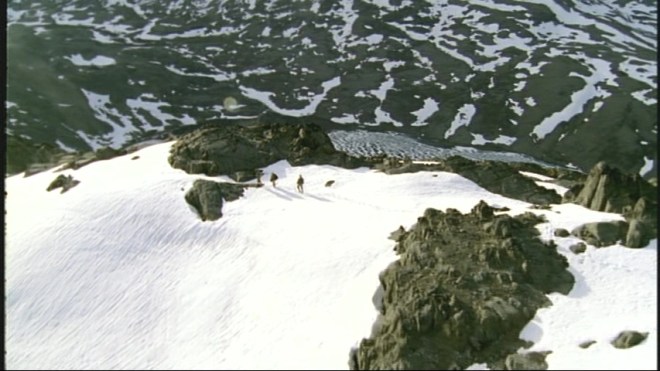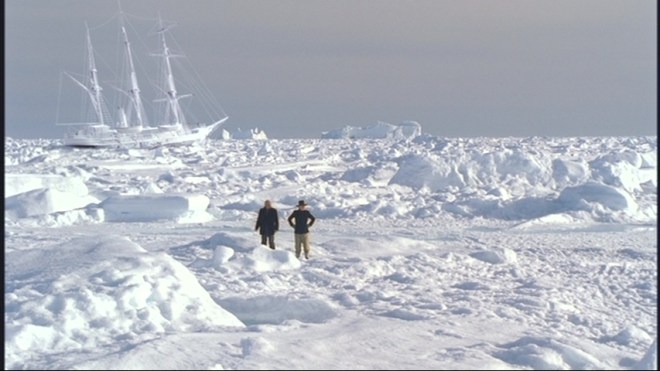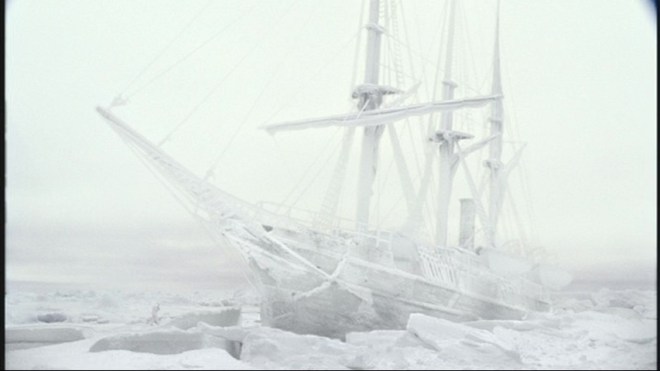Real footage from the legendary Endurance expedition led by Sir Ernest Shackleton edited into documentary form and released just three years after the crew’s return from their harrowing ordeal.
By the seat of their pants…
I have always entertained a dream of visiting the Antarctic. I don’t like crowds (of people, penguins okay), I love geeky, detailed research and have a particular interest in deep sea weirdness. It seems like a perfect destination.
Of course, I know I’ll probably never get there but watching South is the next best thing. It’s real footage shot by Frank Hurley, the Australian cameraman who accompanied Ernest Shackleton’s 1914-1916 attempt to cross Antarctica via the South Pole. (I had a grand time researching this review, by the way.)

It’s no spoiler to say that Shackleton did not succeed in his plan but what he did accomplish is just as impressive. His feat? After his ship, the Endurance, was crushed in Antarctic ice, Shackleton led his crew across the frozen wasteland, undertook a sea journey in three tiny boats, landed on a remote island, left the injured men behind, took a small band on an 800-mile sea voyage to the nearest outpost, climbed a few mountains to get there, and then returned to pick everyone up. Deaths? Zero. He did not lose a single man. Not one.

The film opens with an introductory title explaining that Shackleton’s polar expedition was undertaken with the full support of the government, a necessary precaution against any notion that the crew was shirking on fighting in the First World War. (Frankly, exploring the Antarctic was far more constructive than dying because of an assassination in the Balkans and a couple of exceedingly dim cousins who couldn’t agree to terms via passive-aggressive telegrams. However, it took much of the world some time to admit that fact and so the need for the explanatory title card and showing off Shackleton and company in military garb is quite understandable.)

We are introduced to Shackleton and several notable members of the crew both in uniform and in their polar garb. The early titles have a gently humorous tone to them and it’s easy to see that this was initially planned as a light and entertaining documentary on the wonders of the Antarctic. There were some spats and flare-ups among the crew but a majority of them seemed to share a whimsical sense of humor, which South captures nicely. (Shackleton chose most of his crew personally and spent only a few minutes on each interview, hiring one man because he “looked funny.” This odd method seems to have worked out rather well, all things considered.)

Hurley combines footage of wildlife with stunning images of the Endurance cutting through the icy waters. We are shown the daily life of the crew and many shots of the sled dogs that accompany them on the voyage. (Then as now, cute puppy dogs guarantee a happy audience.) Finally, the Endurance is trapped in ice and Hurley captures the famous, ghostly images of the frozen ship.
The majority of the film is taken up with scenes from the Endurance’s long stint in the ice. Once the ship is crushed in the floes, the amount of footage is minimized. This is not a polished documentary in the modern sense. Hurley was fighting for his life as much as any man in the party and there were times when he simply could not capture the action on film. He was living it. (The weight of the movie camera meant that it had to be left behind once the Endurance was abandoned.) However, Hurley smooths over missing footage with title cards, still photos, paintings and motion pictures taken on a return trip to South Georgia. He manages to construct a narrative with available material and, considering the hardships he endured to bring this footage back with him, we can forgive these very minor issues.

Hurley had an eye for dramatic composition and a taste for the epic; he took extraordinary risks and was rewarded with extraordinary shots. Our intrepid cameraman dangled from the mast of the Endurance, capturing the ice breaking up beneath him; he positioned himself in front of the ship as it attempted to ram its way through stubborn pack ice; he mounted his camera on a dogsled, on mountains of ice, alongside the doomed Endurance as it crumpled under the pressure of the floes. When his plates and film were seemingly lost in the sinking ship, he dove into the slushy water inside to retrieve them. (Way Down East is looking a whole lot less impressive now, isn’t it?)

I should point out, though, that Hurley saw no problem with stitching together assorted elements to create one amazing shot and other techniques frowned upon by journalists and historians. Further, South was released within the lifetimes of most of the survivors and it skirts any issues of morale, insubordination or mistakes that were made during the expedition. For these reasons, as well as the very understandable lack of footage of the voyage to South Georgia, South is best enjoyed alongside other works on Shackleton in order to fill in the gaps. (One major gap: What happened to the dogs? Answer: You really don’t want to know.)

South ends with numerous shots of the wildlife of South Georgia, which may seem like an odd and anticlimactic choice but remember that the film was meant to accompany Shackleton on a lecture tour and seeing the animals of the Antarctic would have been a powerful draw. Fluffy penguins and curious seals would be a bigger attraction than a man with such a tale of survival to tell? Yes, and it’s understandable when we look at the context of its release. The Endurance expedition received attention on its return but it was somewhat overshadowed by both the war and the legend of Scott of the Antarctic.

If you asked a British viewer of 1919 to name the greatest polar explorer, their choice would have almost certainly been the flashy Robert Falcon Scott. Scott was famous before his final expedition but his 1912 death turned him into a legend, a noble adventurer who accepted his doom with dignity. Over the last fifty years or so, Shackleton’s stock has risen enormously while Scott’s has been on a rollercoaster.
Shackleton possessed an important talent as an explorer: an innate instinct that told him when to press on and when to cut his losses. He took his position of leadership seriously and considered the safety of his crew to be paramount. Shackleton didn’t have the dash of Scott or his golden prose but he was uniquely suited to the task of getting an exploration team back in one piece. I can certainly tell you whose team I would rather sign on to join.

Shackleton’s reputation has grown not only because of his heroism but because of the kind of heroism he displayed. Leading people to senseless deaths—especially when such deaths are the result of bungling, poorly communicated orders or apathy from superiors—just doesn’t hold the appeal it once did. “Half a league, half a league, half a league onward” has lost its luster but Shackleton’s determination to get everyone out alive fits our modern notions of heroism to a T. Did he make mistakes and overlook important factors in his planning? Yes, but he also worked tirelessly to maintain morale and keep his men safe, healthy and alive.

Scott and Shackleton were engaged in a race to the South Pole, the cordiality of which is, like most other things about Scott, hotly debated. In any case, the race was won by Norwegian explorer Roald Amundsen, who used dogs, skis, Inuit advice and a strong dose of professionalism to emerge the victor.
I’m not going to venture much further into the deadly ice floes of the Scott vs. Shackleton vs. Amundsen debate but I must say that in my research, I found the proprietary attitude toward the Antarctic displayed by Scott and his defenders to be rather off-putting. (One particularly zealous Scott defender asserted that Amundsen was partially responsible for Scott’s death because winning the race to the pole would have put a spring in Scott’s step, which would have in turn saved his life. Um, that’s not how malnutrition, starvation and exposure work. Amundsen was under no obligation to pack up and return to Norway just because his presence in Antarctica gave Scott the sads.)

Amundsen’s meticulous— though by no means perfect— organization is still praised while the question of whether or not Scott bungled remains a matter of contentious debate with only his most ardent followers finding him blameless in the disaster. (There were a fair number of missteps and back-of-an-envelope calculations, not to mention an aversion to equipment and techniques that would have made for a safer, warmer journey.) That being said, it’s easy to look out from our toasty houses and play armchair explorer. The fact is, though, even with our modern technology, arctic exploration is still unpredictable and deadly. This fact makes the survival of Shackleton and his crew all the more impressive.

South is a priceless historical artifact that has a miraculous tale of survival all its own. The footage that would serve as the backbone of the film was schlepped across the ocean and the fact that we are able to view it today is a testament to the tenacity of both Frank Hurley and Ernest Shackleton. It’s worth seeing for devotees of the golden age of exploration and fans of the documentary film.
Where can I see it?
South was released on DVD by Image but that version is now out of print. I reviewed the edition released by the BFI with restored tints and a suitably rousing piano score by Neil Brand. Other extras include footage of the Ross Sea Party, which was charged with laying supply lines for Shackleton’s cross-Antarctic team. (That crew became stranded as well and lost three men, including the commander of the mission. Shackleton helped rescue them too.)
Due to the fact that South tells only part of the Shackleton story, I opted to view it alongside the 2002 biographical miniseries starring Kenneth Branagh. (I also read Endurance by Alfred Lansing just to fill in any remaining gaps.)
Shackleton (2002)
With three and a half hours of running time, the series has plenty of leeway in creating a well-rounded look at Shackleton. I appreciate that this is not a hagiographical production. We are shown the flaws of our protagonist: his quick temper, his failings as a husband and father, his affair with Rosalind Chetwynd, his pie in the sky schemes. Further, the rest of the Endurance’s crew is allowed to shine and show their contributions to the group’s survival, particularly the brash work of Frank Hurley, the brilliant navigation of Captain Frank Worsley and the sensible ruthlessness of Frank Wild. (No, not everyone on the voyage was named Frank but you would be forgiven for thinking it.)
We are shown the planning stages of the expedition and the lengths Shackleton had to go to secure financing. While I understand the desire to establish the character of Shackleton before the Endurance expedition and to show the hucksterism that was a necessary part of the exploration game, the first half of the series feels bogged down. Shackleton’s interviews with potential team members are amusing, as are his attempts to raise money and I do feel that showing his family life is important but the series is nearly half over before he finally sets sail. I realize that the real expedition took four years to plan and mount but there’s no reason why it has to take four years on the screen as well.
For all this, the story seems strangely crowded, it’s hard to keep track of who’s who in the crew, so many names fly at us at once. I’m sure experts on the Endurance mission will recognize these men at once but more casual viewers will be overwhelmed. Frankly, the story would have been better served by opening with the start of the expedition, or even a scene of the Endurance encased in ice or the men stranded on Elephant Island, and filling in gaps with flashbacks.
Worse, the conflicts introduced during the slow beginning do not pay off in any meaningful way later in the film. Shackleton and his men get themselves into trouble and they get themselves out. Showing everyone back in England looking worried and/or apathetic doesn’t add much to the story, nor does inserting a scene of Emily Shackleton and Rosalind Chetwynd bonding over motherhood. Because, clearly, that’s what women have in common.
(Off-topic, I suppose, but here is an article written by Chetwynd in 1918 advising American women to steer clear of British men. She complains that they cheat on their wives. Why, the very idea!)

While I recognize the need for film and television adaptations to take dramatic license, I found some of the changes to the historical record to be both inexplicable and unnecessary. For example, Leonard Hussey (meteorologist) had a banjo, which he joked that he could play just well enough to annoy the neighbors. Recognizing its importance as a morale builder, Shackleton made sure that the banjo was saved and taken along throughout the journey. However, the miniseries shows the banjo being discarded with all the other excess baggage before the trek across the floes. I’m not sure what the point of that was, especially when Hussey and his banjo were given special recognition in South. (The instrument was signed by expedition members and is now part of the collection of the National Maritime Museum.)

Here’s a small content warning. While viewers of this miniseries will expect frostbite, gangrene and other nasty business related to the extreme weather conditions, I should also point out that all the dogs and the cat taken on the Endurance expedition die or are killed and some of the animals are eaten. In South, the dogs disappear quietly from the narrative without explanation. I won’t go into detail about what happens in Shackleton except to say that the scenes are unambiguous. Viewers who are sensitive to such content are duly warned. I certainly had to look away at some points.
(Oh, and one main complaint about Amundsen was that he ate some of his sled dogs, factoring their meat into his survival plans. Well, I hate to break it to you but Scott ate his ponies. We can all agree that Antarctic explorers aren’t going to win any awards from the ASPCA but I find this sole focus on Amundsen to be odd.)
Once Shackleton gets to the point, it’s an excellent narrative of survival under harsh conditions. The cast gives it their all and the whole thing feels suitably organic. I appreciate the production making the effort to shoot on location in Greenland and Iceland (no one would expect the crew to risk the real Antarctic) and using practical effects where possible. CGI imagery can be gorgeous but it also has a plasticky, weightless quality to it; I enjoyed real ice, real snow and real scenery.
Based on the footage of the real Shackleton, it seems to me that Kenneth Branagh does an admirable job of capturing the man’s look and mannerisms. Further, he nicely conveys the humor, mood swings and eccentricity that were key components to Shackleton’s personality.
Shackleton has its flaws but its high production values make it worth a watch. Branagh is a creditable commander and I appreciated the reasonably unflinching look at the hardships of the Endurance expedition. It makes an excellent companion piece to South.
Availability: Released on DVD.
***
Like what you’re reading? Please consider sponsoring me on Patreon. All patrons will get early previews of upcoming features, exclusive polls and other goodies.








A review of South that does this amazing doc proud- great job, and thank you!!!
Thank you so much!
I always thought that “Shakleton” has just a little too much Branagh giving his “performance” and not quite enough of the rest of the crew and the situation.
Tom Crean (the third guy that went the whole distance), is particularly cut out which is too bad.. He had distinguished himself on Scott’s expedition when he and another (Chief Stoker Lashly) hauled the commander of the last party sent back 70+ miles when he went down with skurvy, Crean then walked another 28 (on foot) to get help. It would show something of Shakleton’s differences from Scott (he did not lean on Ranks and “Navy ways”) to know that this former “ranker” was the second officer. Wild was also a former RN Petty officer (roughly a sergeant) before he became Shackleton’s 2nd in command.
BTW, if you want the really gruesome tale of surviving in this era, read “Mawson’s Will”.
Well, the miniseries is called “Shackleton” and not “Crean” so I don’t really have any cause to complain on that score. Further, the filmmakers seemed to have been deliberately sidestepping the Scott debate, which I don’t really blame them for doing and focusing on Crean would have brought that issue front and center. In the end, the miniseries had three and a half hours but the crew of the Endurance consisted of almost 30 men. Omissions were inevitable and for the sake of the story, Crean and Wild basically filled the same role of Antarctic veteran. (First rule of writing: Never have two characters do the work of one.)
When South was filmed the word documentary did not exist. I note Tom Crean mentioned above. The pub that he ran in Kerry still exists and his owned by a relation. I had a beer and some food their about nine years ago. A nice place.
Pedantry for pedantry: The first known use of the word documentary was in 1802. True, it was not applied to films at the time but, as I said, pedantry.
https://www.merriam-webster.com/dictionary/documentary
South is broadly classified as a documentary (as are many silent non-fiction films) and I have absolutely no qualms about using this classification in the context of a review.
Some of Hurley’s material was used in the IMax film “Shackleton’s Antarctic Adventure” which I saw a few years ago.
http://main.wgbh.org/imax/shackleton/sirernest-two.html
I’ve been to the Antarctic, but sadly only via the screen of a Moviola 😦
I cut a science oriented TV series for New Zealand National Film Unit about the continent. The sound guy couldn’t quite comprehend the silence there.
The NZNFU has a proud record re Antarctica, they made a film about Sir Edmund Hillary crossing it, in a tractor, to meet up with a British expedition which utilised the latest and greatest in transportation for rugged terrain.
Glad they finally got one of those things to work. (Antarctic tractors, that is) 🙂
I love the tale of Shackleton and the Endurance, and have read several books about it, but somehow have never seen either of these films. I shall have to do so!
They really are breathtaking, especially if you are familiar with the background.
Well it isn’t just the skimming of the crew (Crean aside, an fair chunk of Endurance’s crew had gone south with Scott and/Shackleton before). The other thing I miss is it doesn’t get enough of the age into it. (Especially since these men left one world and really came back to another). It looks great (better than Last Place on Earth) but I just feel the script is too thin, I can see that “Shackles” is a special sort of leader, but we don’t get enough of the man, and how his straightforward ambition really didn’t play with his time (he was considered a bit of a bounder and upstart, and his brother being implicated in the theft of the (Irish) crown Jewels didn’t help.
And take more time away from Crean? Unthinkable!
Not just the dogs – Shackleton had Mrs Chippy, the ship’s cat, shot. I always feel sad when I think of that.
Yes, I make mention of that in the review of Shackleton. These pictures are to be approached with caution by animal lovers.